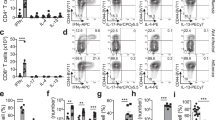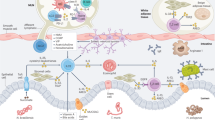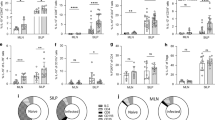Abstract
Although primary and memory responses against bacteria and viruses have been studied extensively, T helper type 2 (TH2) effector mechanisms leading to host protection against helminthic parasites remain elusive1. Examination of the intestinal epithelial submucosa of mice after primary and secondary infections by a natural gastrointestinal parasite revealed a distinct immune-cell infiltrate after challenge, featuring interleukin-4–expressing memory CD4+ T cells that induced IL-4 receptorhi (IL-4Rhi) CD206+ alternatively activated macrophages2. In turn, these alternatively activated macrophages (AAMacs) functioned as important effector cells of the protective memory response contributing to parasite elimination, demonstrating a previously unknown mechanism for host protection against intestinal helminths.
This is a preview of subscription content, access via your institution
Access options
Subscribe to this journal
Receive 12 print issues and online access
$209.00 per year
only $17.42 per issue
Buy this article
- Purchase on Springer Link
- Instant access to full article PDF
Prices may be subject to local taxes which are calculated during checkout




Similar content being viewed by others

References
Gause, W.C., Urban, J.F., Jr. & Stadecker, M.J. The immune response to parasitic helminths: insights from murine models. Trends Immunol. 24, 269–277 (2003).
Noel, W., Raes, G., Hassanzadeh Ghassabeh, G., De Baetselier, P. & Beschin, A. Alternatively activated macrophages during parasite infections. Trends Parasitol. 20, 126–133 (2004).
Mosmann, T.R., Cherwinski, B., Bond, M.W., Giedlin, M.A. & Coffman, R.L. Two types of murine helper T cell clone. I. Definition according to profiles of lymphokine activities and secreted proteins. J. Immunol. 136, 2348–2357 (1986).
Maizels, R.M. et al. Helminth parasites—masters of regulation. Immunol. Rev. 201, 89–116 (2004).
Zhu, Z. et al. Acidic mammalian chitinase in asthmatic Th2 inflammation and IL-13 pathway activation. Science 304, 1678–1682 (2004).
Herbert, D.R. et al. Alternative macrophage activation is essential for survival during schistosomiasis and downmodulates T helper 1 responses and immunopathology. Immunity 20, 623–635 (2004).
Loke, P. et al. IL-4 dependent alternatively-activated macrophages have a distinctive in vivo gene expression phenotype. BMC Immunol. 3, 7 (2002).
Urban, J.F., Jr., Katona, I.M., Paul, W.E. & Finkelman, F.D. Interleukin 4 is important in protective immunity to a gastrointestinal nematode infection in mice. Proc. Natl. Acad. Sci. USA 88, 5513–5517 (1991).
Persson, L. A modified baermann apparatus for the recovery of infective nematode larvae from herbage and manure. Zentralbl. Veterinarmed. B. 21, 483–488 (1974).
Morimoto, M. et al. Peripheral CD4 T cells rapidly accumulate at the host:parasite interface and express a polarized Th2 memory response in situ. J. Immunol. 172, 2424–2430 (2004).
Liu, Z. et al. Requirements for the development of IL-4-producing T cells during intestinal nematode infections: what it takes to make a Th2 cell in vivo. Immunol. Rev. 201, 57–74 (2004).
Voehringer, D., Reese, T.A., Huang, X., Shinkai, K. & Locksley, R.M. Type 2 immunity is controlled by IL-4/IL-13 expression in hematopoietic non-eosinophil cells of the innate immune system. J. Exp. Med. 203, 1435–1446 (2006).
Wynn, T.A. Fibrotic disease and the T(H)1/T(H)2 paradigm. Nat. Rev. Immunol. 4, 583–594 (2004).
van Rooijen, N., Bakker, J. & Sanders, A. Transient suppression of macrophage functions by liposome-encapsulated drugs. Trends Biotechnol. 15, 178–185 (1997).
Gobert, A.P. et al. Protective role of arginase in a mouse model of colitis. J. Immunol. 173, 2109–2117 (2004).
Kuwano, K. et al. Oxidative stress in lung epithelial cells from patients with idiopathic interstitial pneumonias. Eur. Respir. J. 21, 232–240 (2003).
Mei, B., Komuniecki, R. & Komuniecki, P.R. Localization of cytochrome oxidase and the 2-methyl branched-chain enoyl CoA reductase in muscle and hypodermis of Ascaris suum larvae and adults. J. Parasitol. 83, 760–763 (1997).
Takamiya, S. et al. Molecular and functional properties of cytochrome c from adult Ascaris suum muscle. Mol. Biochem. Parasitol. 79, 61–70 (1996).
Goerdt, S. et al. Alternative versus classical activation of macrophages. Pathobiology 67, 222–226 (1999).
Mantovani, A., Sica, A. & Locati, M. Macrophage polarization comes of age. Immunity 23, 344–346 (2005).
Hesse, M. et al. Differential regulation of nitric oxide synthase-2 and arginase-1 by type 1/type 2 cytokines in vivo: granulomatous pathology is shaped by the pattern of L-arginine metabolism. J. Immunol. 167, 6533–6544 (2001).
Bronte, V. & Zanovello, P. Regulation of immune responses by L-arginine metabolism. Nat. Rev. Immunol. 5, 641–654 (2005).
Madden, K.B. et al. Enteric nematodes induce stereotypic STAT6-dependent alterations in intestinal epithelial cell function. J. Immunol. 172, 5616–5621 (2004).
Shea-Donohue, T. et al. The role of IL-4 in Heligmosomoides polygyrus-induced alterations in murine intestinal epithelial cell function. J. Immunol. 167, 2234–2239 (2001).
Zhao, A. et al. Dependence of IL-4, IL-13, and nematode-induced alterations in murine small intestinal smooth muscle contractility on Stat6 and enteric nerves. J. Immunol. 171, 948–954 (2003).
Cliffe, L.J. et al. Accelerated intestinal epithelial cell turnover: a new mechanism of parasite expulsion. Science 308, 1463–1465 (2005).
Ben-Smith, A., Lammas, D.A. & Behnke, J.M. The relative involvement of Th1 and Th2 associated immune responses in the expulsion of a primary infection of Heligmosomoides polygyrus in mice of differing response phenotype. J. Helminthol. 77, 133–146 (2003).
Pennock, J.L. & Grencis, R.K. The mast cell and gut nematodes: damage and defence. Chem. Immunol. Allergy 90, 128–140 (2006).
Nair, M.G. et al. Chitinase and Fizz family members are a generalized feature of nematode infection with selective upregulation of Ym1 and Fizz1 by antigen-presenting cells. Infect. Immun. 73, 385–394 (2005).
Murakami, H., Liotta, L. & Star, R.A. IF-LCM: laser capture microdissection of immunofluorescently defined cells for mRNA analysis rapid communication. Kidney Int. 58, 1346–1353 (2000).
Acknowledgements
The authors would like to thank F.D. Finkelman, S.J. Leibovich and E.J. Allenspach for critically reviewing this manuscript.
Author information
Authors and Affiliations
Corresponding author
Ethics declarations
Competing interests
The authors declare no competing financial interests.
Supplementary information
Supplementary Fig. 1
The life cycle of H. polygyrus. (PDF 144 kb)
Supplementary Fig. 2
An inflammatory Th2 microenviroment develops around Hp larvae 4 days after challenge. (PDF 205 kb)
Supplementary Fig. 3
CD4+ T cells from Hp primed and drug cured mice can transfer protection to wild type, but not stat6−/− mice. (PDF 1263 kb)
Supplementary Fig. 4
Collagen is deposited around the parasite at later stages of a challenge infection and is associated with the Th2 inflammatory response. (PDF 189 kb)
Rights and permissions
About this article
Cite this article
Anthony, R., Urban, J., Alem, F. et al. Memory TH2 cells induce alternatively activated macrophages to mediate protection against nematode parasites. Nat Med 12, 955–960 (2006). https://doi.org/10.1038/nm1451
Received:
Accepted:
Published:
Issue Date:
DOI: https://doi.org/10.1038/nm1451
This article is cited by
-
Cooperation of ILC2s and TH2 cells in the expulsion of intestinal helminth parasites
Nature Reviews Immunology (2024)
-
Metabolic heterogeneity of tissue-resident macrophages in homeostasis and during helminth infection
Nature Communications (2023)
-
Trained immunity in type 2 immune responses
Mucosal Immunology (2022)
-
The IL-25-dependent tuft cell circuit driven by intestinal helminths requires macrophage migration inhibitory factor (MIF)
Mucosal Immunology (2022)
-
Integrative biology defines novel biomarkers of resistance to strongylid infection in horses
Scientific Reports (2021)


